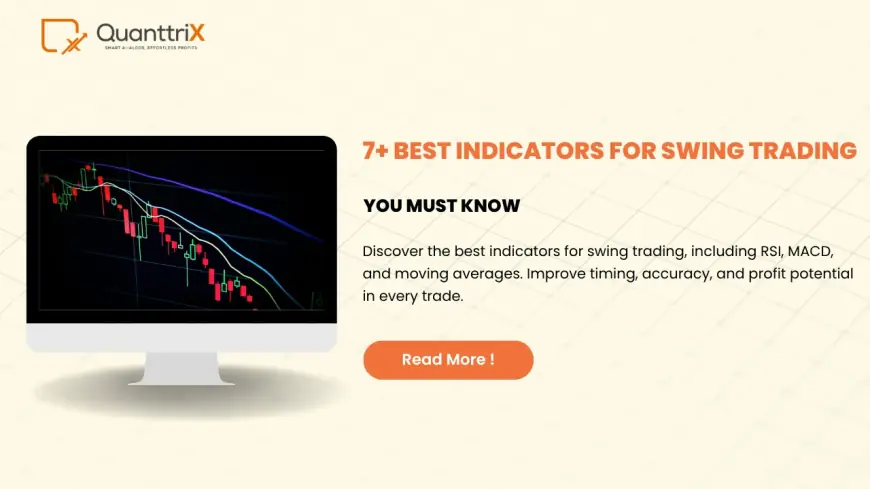Best Indicators for Swing Trading & Top Tools in India
Discover the best indicators for swing trading, swing trade scanner tips, and the best algo trading software in India for success in today's market.

Best Indicators for Swing Trading: Your Ultimate Guide
Introduction
Imagine you're a surfer, poised on the shore, scanning the waves and waiting for that perfect moment to ride. Swing trading is a lot like surfing. You don’t need to catch every wave, but you want to ride the good ones that last long enough for a thrilling journey. But how can you tell which “waves” in the market are worth your attention? That’s where swing trading indicators, swing trade scanners, and smart algo software step in to help.
This article breaks down the best indicators for swing trading in plain English. Whether you’re a beginner hoping to spot your first winning trade or a more seasoned surfer improving your ride, you’ll find useful, actionable insights here. Plus, we’ll touch on swing trade scanners and the best algo trading software in India—making your trading journey smoother and more successful.
Discover the best indicators for swing trading, swing trade scanner tips, and the best algo trading software in India for success in today's market.
What is Swing Trading?
Swing trading is like playing chess rather than checkers. Traders look for opportunities to profit from short- to medium-term price swings—that is, major up or down moves that happen over a few days to several weeks. Unlike day traders who jump in and out within hours, swing traders are content with holding positions a bit longer, aiming for bigger “chunks” of profit.
Why Indicators Matter in Swing Trading
Indicators are your navigational tools in the world of swing trading. Think of them as the GPS that guides you through market ups and downs. They don’t guarantee success (no tool does!), but they stack the odds in your favor by helping you make informed decisions about when to enter or exit a trade.
Moving Averages: The Market’s Compass
Simple Moving Average (SMA)
A Simple Moving Average (SMA) helps “smooth out” price data by creating a constantly updated average price. For swing traders:
-
A rising SMA can signal a possible buying opportunity.
-
A falling SMA suggests a potential sell.
Popular settings: 20-day, 50-day, or 200-day SMAs are common for swing traders.
Exponential Moving Average (EMA)
EMAs give more weight to recent prices, making them quicker to react to market changes. Many swing traders love the 9-day and 21-day EMAs for spotting short-term trends.
Relative Strength Index (RSI): Reading Market Momentum
The RSI is like a fuel gauge for a stock:
-
An RSI above 70 means a market is “overbought”—possibly due for a pullback.
-
An RSI below 30 means it’s “oversold”—possibly ready to rebound.
RSI helps you avoid “buying high” and “selling low,” making it one of the best indicators for swing trading.
Moving Average Convergence Divergence (MACD): Trend Decoder
The MACD helps you see both the direction and momentum of a trend:
-
When the MACD line crosses above its signal line, it may be time to buy.
-
When it crosses below, that’s often a sell signal.
It’s like checking the wind before you set sail—the MACD shows which way the market “breeze” is blowing.
Bollinger Bands: Visualizing Volatility
Bollinger Bands create an envelope around price using standard deviations. This lets you “see” when price is:
-
Near the top band (overbought)
-
Near the bottom band (oversold)
For swing traders, bands that squeeze together often signal a big move is coming.
Fibonacci Retracement: Spotting Potential Reversals
You’ve probably heard quips about “the magic of Fibonacci.” It isn’t magic, but traders use Fibonacci retracement levels (like 23.6%, 38.2%, 50%, and 61.8%) to spot potential reversal zones. These can help you predict where a price might bounce after a run-up or pullback—crucial for timing entries and exits.
Stochastic Oscillator: Timing Your Entry Like a Pro
This tool compares a stock’s closing price to its range over a specific period. If you want to buy low and sell high:
-
Values above 80 can mean the market is overbought.
-
Values below 20 can indicate oversold conditions.
Pairing the Stochastic Oscillator with moving averages can enhance your trade accuracy.
Volume Indicators: Confirming Market Moves
Volume is like the applause at a concert—the louder it gets, the more “real” the move is. Volume indicators (like On-Balance Volume or Volume Oscillator) let you confirm a breakout or breakdown before you jump in.
Key points:
-
Rising price + rising volume = trend likely to continue
-
Rising price + falling volume = trend may weaken
Average True Range (ATR): Measuring Market “Noise”
Markets can sometimes get noisy with random ups and downs. The ATR tells you how much an asset typically moves in a day. High ATR means big swings (more risk and opportunity), while low ATR signals calmer waters. Adjust your stop-loss orders accordingly for safer, smarter trades.
Combination Strategies: Why One Tool Isn’t Enough
Just as a chef uses many ingredients to cook a delicious meal, savvy swing traders often combine several indicators for better results. For example, you might enter a trade when RSI is bullish and the moving averages are lining up in your favor. This layered approach reduces “false signals” and boosts your confidence.
Swing Trade Scanners: Your Market Searchlight
Scanning the entire market daily for quality trades is nearly impossible manually. That’s where swing trade scanners come in. These automated tools quickly sift through hundreds of stocks to find those meeting your chosen indicator criteria.
Some swing trade scanner tips:
-
Set up filters for technical indicator signals (like RSI <30 or EMA crossovers)
-
Use built-in screeners on platforms like TradingView, Zerodha, or Upstox for Indian markets
-
Save custom scans to catch new trade ideas every day
Best Algo Trading Software in India
India’s market is brimming with technology-driven tools for swing traders. The best algo trading software in India not only automates trade executions but often supports back-testing, portfolio management, and built-in indicators.
Some top choices include:
-
Quanttrix: Allows no-code strategy creation and extensive back-testing, perfect for swing trading signal automation.
-
Alice Blue ANT: Offers advanced charting, algo integration, and scalable auto-trade features.
-
Upstox Pro: Known for its fast execution and customizable algorithmic strategies.
Tip: Look for robust support, lots of indicators, and clean interface when choosing software.
Building Your Own Winning Swing Trading System
Start simple:
-
Choose 2-3 indicators you understand best.
-
Backtest your strategy (most algo trading tools offer this) to see how it performs on historical data.
-
Refine, optimize, and don’t be afraid to tweak your system as you grow.
Remember, consistency and discipline are your best friends in swing trading.
Common Mistakes to Avoid
-
Chasing every trade: Not every “wave” is worth riding. Be selective.
-
Ignoring the trend: Don’t fight the bigger wave—trade with the trend, not against it.
-
Overcomplicating setups: Simple systems often work best.
-
Neglecting risk management: Always set stop-loss orders and size trades responsibly.
-
Relying on one indicator: Combine tools for confirmation, but avoid overloading your chart.
Conclusion
Swing trading can be as exhilarating as surfing the perfect wave—you’re looking for those moments in the market where momentum, signals, and opportunities line up. By understanding the best indicators for swing trading, using smart swing trade scanners, and leveraging the best algo trading software in India, you put yourself ahead of the curve.
The tools discussed here are designed to make your swing trading journey smoother, smarter, and more successful. So, grab your “surfboard,” scan the horizon, and ride those market waves—all with the confidence of someone who knows what signals to watch. Ready to catch your next swing?
Frequently Asked Questions (FAQs)
1. What are the best indicators for swing trading?
The best indicators include moving averages (like SMA and EMA), RSI, MACD, Bollinger Bands, Fibonacci levels, Stochastic Oscillator, volume indicators, and ATR. Combining a few can give more reliable trade signals.
2. How do swing trade scanners work?
Swing trade scanners automatically filter the market using your chosen indicators and criteria, quickly surfacing stocks that fit your swing trading setup. This saves time and helps you find more quality trades.
3. What is the best algo trading software in India for swing traders?
Top picks include Quanttrix, Alice Blue ANT, and Upstox Pro, all of which support swing trading strategies, indicator-based scans, and rapid execution.
4. Can I rely on indicators alone for swing trading success?
Indicators provide valuable clues but are most effective when combined with strong risk management, good market sense, and discipline. No indicator or tool guarantees profits.
5. Is swing trading suitable for beginners?
Yes! Swing trading’s pace allows for thoughtful decision-making and learning. By starting small, practicing with indicators, and gradually building up, beginners can find success.
What's Your Reaction?
 Like
0
Like
0
 Dislike
0
Dislike
0
 Love
0
Love
0
 Funny
0
Funny
0
 Angry
0
Angry
0
 Sad
0
Sad
0
 Wow
0
Wow
0


















































